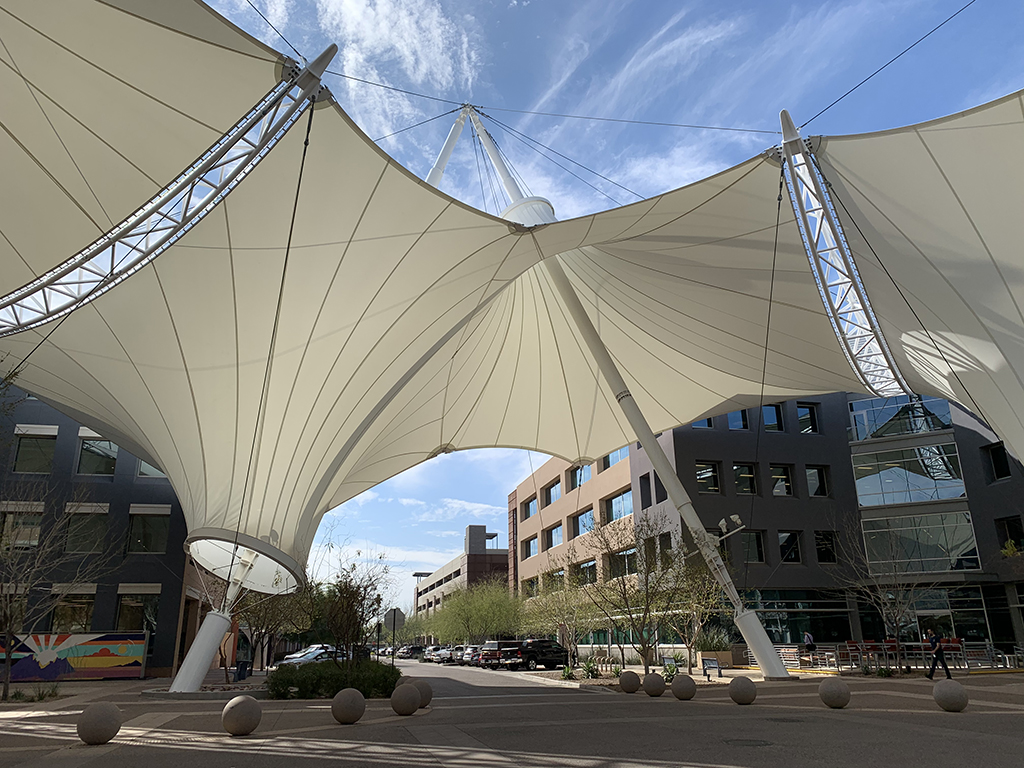SkySong and Scottsdale’s Mood Ring
By Kevin Vaughan-Brubaker, Public Art Manager

Scottsdale very nearly had its own mood ring. No, not in the 1960s, but in the 2010s. How did this idea almost come to pass? To find out is to delve into the long history of SkySong and public art.
In 2005, the city of Scottsdale and Arizona State University agreed to redevelop the abandoned Los Arcos Mall at the corner of McDowell Road and Scottsdale Road. A year later, Plaza Companies were selected to develop the project: SkySong, The ASU Scottsdale Innovation Center. In 2008, the first two buildings opened, generating curiosity and interest in the site. While the faltering economy slowed SkySong’s progress, by 2011, the buildings were close to capacity and more structures were planned. SkySong was well on its way to reaching its potential as an entrepreneurial business and technology incubator space.
Up to this point, the capital projects at SkySong had generated public art dollars as part of an agreement based on the city’s Public Art Ordinance (Art in Public Places) and the its Cultural Improvement Program (Art in Private Development). All that was needed was an artist with a compelling idea to match SkySong’s lofty goals. Enter New York artist, Ed Purver. His idea focused on the Iconic Shade Structure in the middle of SkySong’s campus. You might not know where SkySong is by name, but you’ve probably seen the majestic white sails and elegant support beams that look like an alien spacecraft. At that time, Iconic Shade Structure dominated the campus. Even as buildings sprouted on the south and west sides of the campus, the shade structure still stole the show. Purver wanted to turn that show into a “mood ring” that displayed the overall emotion of Scottsdale.

At that moment, social media was ascending in popularity and Twitter held a key place in Purver’s idea. Purver’s art focused on using data to drive the programming of lights and projections. His idea was to install additional LED fixtures on the Iconic Shade Structure to enhance the color palette and make existing lighting more dynamic. Ed’s brother, Matthew Purver, is a professor in computational linguistics who wrote a program that identified words people tweeted and assigned them a color value according to a list of emotions. An angry tweet would be red, a happy tweet would be green, a sad tweet would be blue, and so forth. Ed’s idea was to use this program to control the lighting on the Iconic Shade Structure.

The program would identify all tweets from inside the boundaries of Scottsdale by the main emotion they expressed. The data would be compiled by the program and the corresponding color of the dominant emotion expressed in Scottsdale that day would shine onto the surface and underside of the shade structure. If most of the tweets in Scottsdale were happy, the shade structure would be green that night. People on SkySong’s campus, folks driving in that area, or travelers looking down from airplanes, would see what Scottsdale’s overall mood was according to nightly color.
As groovy as Ed’s idea was, one realization stopped the project in its tracks. During the design process, the developers noted that the eventual build-out of the campus would hide the Iconic Shade Structure on every side behind tall buildings. Scottsdale’s mood ring would be visible only to those on the campus. Because public art projects should be as visible and accessible as possible, spending the money to make Ed’s mood ring a reality did not seem to be the best use of those funds. We ended Ed’s contract and agreed with SkySong’s owners and city administrators that we would take a step back and look for another artist to come up with a design for public art at SkySong.
The story of public art at SkySong will be continued in future blog entries.
Back to Immerse home.
CONNECTIONS: Spark | Amplify | Inspire


